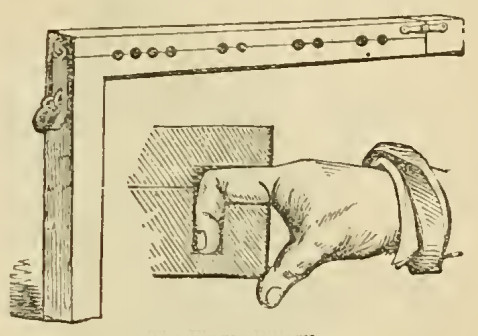In 2004, Canadian musician Andrew Huang wrote a song that encodes the first 101 digits of π.
Also: A “piku” is a haiku whose word lengths reflect the digits of π:
How I love a verse
Contrived to unhusk dryly
One image nutshell
In 2004, Canadian musician Andrew Huang wrote a song that encodes the first 101 digits of π.
Also: A “piku” is a haiku whose word lengths reflect the digits of π:
How I love a verse
Contrived to unhusk dryly
One image nutshell
William Hone’s Every-Day Book of 1837 repeats a story in which St. Martin meets the devil, who asks why he is walking to Rome rather than riding. The saint commands him to become a beast of burden, the devil assumes the shape of a mule, and Martin jumps onto his back and spurs him on his way by repeatedly making the sign of the cross. At length the devil says:
Signa te, Signa: temere me tangis et angis:
Roma tibi subito motibus ibit amor.
That means “Cross, cross thyself — thou plaguest and vexest me without necessity; for, owing to my exertions, Rome, the object of thy wishes, will soon be near.” And each line is a palindrome, reading the same backward and forward.
Hone adds, “These lines have been quoted imperfectly and separately in ‘Encyclopedies’ and other books, under the words ‘Palindromical verses;’ but the reader will not easily meet with the legendary tale, which gives them historical consistence and meaning.”

In 1969, solicitor James Jarvis booked a skiiing holiday in Switzerland. A brochure from Swan Tours Ltd. described the attractions in Mörlialp, Giswil, thus:
House Party Centre with special resident host. … Mörlialp is a most wonderful little resort on a sunny plateau … Up there you will find yourself in the midst of beautiful alpine scenery, which in winter becomes a wonderland of sun, snow and ice, with a wide variety of fine ski-runs, a skating rink and exhilarating toboggan run … Why did we choose the Hotel Krone … mainly and most of all because of the ‘Gemütlichkeit’ and friendly welcome you will receive from Herr and Frau Weibel. … The Hotel Krone has its own Alphütte Bar which will be open several evenings a week. … No doubt you will be in for a great time, when you book this houseparty holiday … Mr. Weibel, the charming owner, speaks English. …
All these House Party arrangements are included in the price of your holiday. Welcome party on arrival. Afternoon tea and cake for 7 days. Swiss dinner by candlelight. Fondue party. Yodeler evening. Chali farewell party in the ‘Alphütte Bar’. Service of representative.
He flew out on Dec. 20 and flew back on Jan. 3 in a bitter and unrefreshed state of mind. Mr. Weibel, the charming owner, certainly had not spoken English, and the vaunted house party had amounted to 13 people in the first week and zero in the second. In the subsequent lawsuit for breach of contract, Tom Denning, the Master of the Rolls, wrote:
So there was Mr. Jarvis, in the second week, in this hotel with no house party at all, and no one could speak English, except himself. He was very disappointed, too, with the ski-ing. It was some distance away at Giswil. There were no ordinary length skis. There were only mini-skis, about 3 ft. long. So he did not get his ski-ing as he wanted to. In the second week he did get some longer skis for a couple of days, but then, because of the boots, his feet got rubbed and he could not continue even with the long skis. So his ski-ing holiday, from his point of view, was pretty well ruined.
There were also no Swiss cakes, just crisps and little dry nut cakes. The ‘yodeler’ was a local man who came in work clothes and sang four or five songs quickly. The ‘Alphütte Bar’ was empty and only open one evening.
Jarvis had paid £63.45, and the trial judge, estimating that he’d received about half of what was promised, awarded him £31.72. But Denning went further: He judged that Jarvis’ disappointment in itself constituted a damage and deserved to be compensated. “I think the judge was in error in taking the sum paid for the holiday £63.45 and halving it. The right measure of damages is to compensate him for the loss of entertainment and enjoyment which he was promised, and which he did not get.” He awarded Jarvis £125.
(Jarvis v Swans Tours Ltd [1972] EWCA Civ 8 [16 October 1972])

In 2005, as the Art League of Houston planned to demolish two houses it owned, it invited sculptors Dan Havel and Dean Ruck to transform them first. So they peeled off the buildings’ skins and arranged them into a vortex to another dimension.
Six years later they extended the same treatment to other dilapidated houses in Houston:


In natural language, the most frequent word occurs about twice as often as the second most frequent word, three times as often as the third most frequent word, and so on.
In the Brown Corpus, a text collection of a million words, the most frequent word, the, accounts for 7.5% of all word occurrences, and the second most frequent, of, accounts for 3.5%. A mere 135 vocabulary items account for half the corpus, and about half the total vocabulary of about 50,000 words are hapax legomena, words that occur once only.
Similar distributions are found in data throughout the physical and social sciences; the law is named after the American linguist George Kingsley Zipf.
A striking paragraph from A Woman’s Work Is Never Done, Caroline Davidson’s 1982 history of housework in the British Isles:
One woman actually entered the nascent electrical industry in the 1870s. Pretending to be a man (she assumed the name of Charles Torr) she rose to become managing director of a large Birmingham firm called Winfield’s which produced ornamental brass-work, chandeliers and fittings suitable for interior electric lighting. She joined a dining society of electrical engineers called the ‘Dynamicables’ where many of the problems facing the new industry were discussed. She obviously had the vision to see electricity’s brilliant future, as well as a flair for business and exceptional talent for concealing her sex. For, in the early 1880s, she approached Rookes E.B. Crompton with a proposal that their two firms should go into partnership; Compton’s was to carry out lighting installations and Winfield’s was to supply the capital and fitments. Her plans were extremely grand: she wanted to apply for a Parliamentary act to light Birmingham and to sell electrical goods world-wide. However, after the two firms had co-operated for several years, Winfield’s ran into financial difficulties and Charles Torr committed suicide: only then did her colleagues learn her true sex.
I haven’t been able to learn anything more. Davidson cites Crompton’s Reminiscences of 1928, which is unfortunately rare.

The streets of Europe are studded with thousands of brass plates, each marking the last residence of an individual before their extermination or persecution by the Nazis. German artist Gunter Demnig began the project in 1992, installing the first plate before Cologne’s city hall to mark the 50th anniversary of Heinrich Himmler’s “Auschwitz decree” ordering the deportation of Sinti and Roma to extermination camps. In the ensuing 15 years he laid more than 13,000 stolpersteine in more than 280 cities, and last October the 70,000th stolperstein was installed in Frankfurt, Germany, for Willy Zimmerer, who was “euthanized” in 1944 at age 43.
Each plate is engraved with the victim’s name and dates of birth, deportation, and death, as well as the words Hier wohnte … (“Here lived …”) to emphasize the immediacy of the memorial, “tripping up” passersby (stolperstein means “stumbling stone”). “I wanted to bring back the names of the Jews who lived, loved, had children and a normal life, who lived in these houses,” Demnig has said. “It’s my life. We can’t allow this part of history to pass into oblivion.”
(Thanks, Hanno.)

Here’s a forgotten punishment. In the 17th century, in return for a minor offense such as not attending to a sermon, a wrongdoer might be required to place his finger into an L-shaped hole over which a block was fastened to keep the knuckle bent. “[T]he finger was confined, and it will easily be seen that it could not be withdrawn until the pillory was opened,” writes William Andrews in Medieval Punishments (1898). “If the offender were held long in this posture, the punishment must have been extremely painful.”
In his 1686 history of Staffordshire, Robert Plot recalls a “finger-Stocks” “made for punishment of the disorders, that sometimes attend feasting at Christmas time.” Into this “the Lord of misrule, used formerly to put the fingers of all such persons as committed misdemeanors, or broke such rules, as by consent were agreed on for the time of keeping Christmas, among servants and others of promiscuous quality.”

“Comparison is the thief of joy.” — Theodore Roosevelt